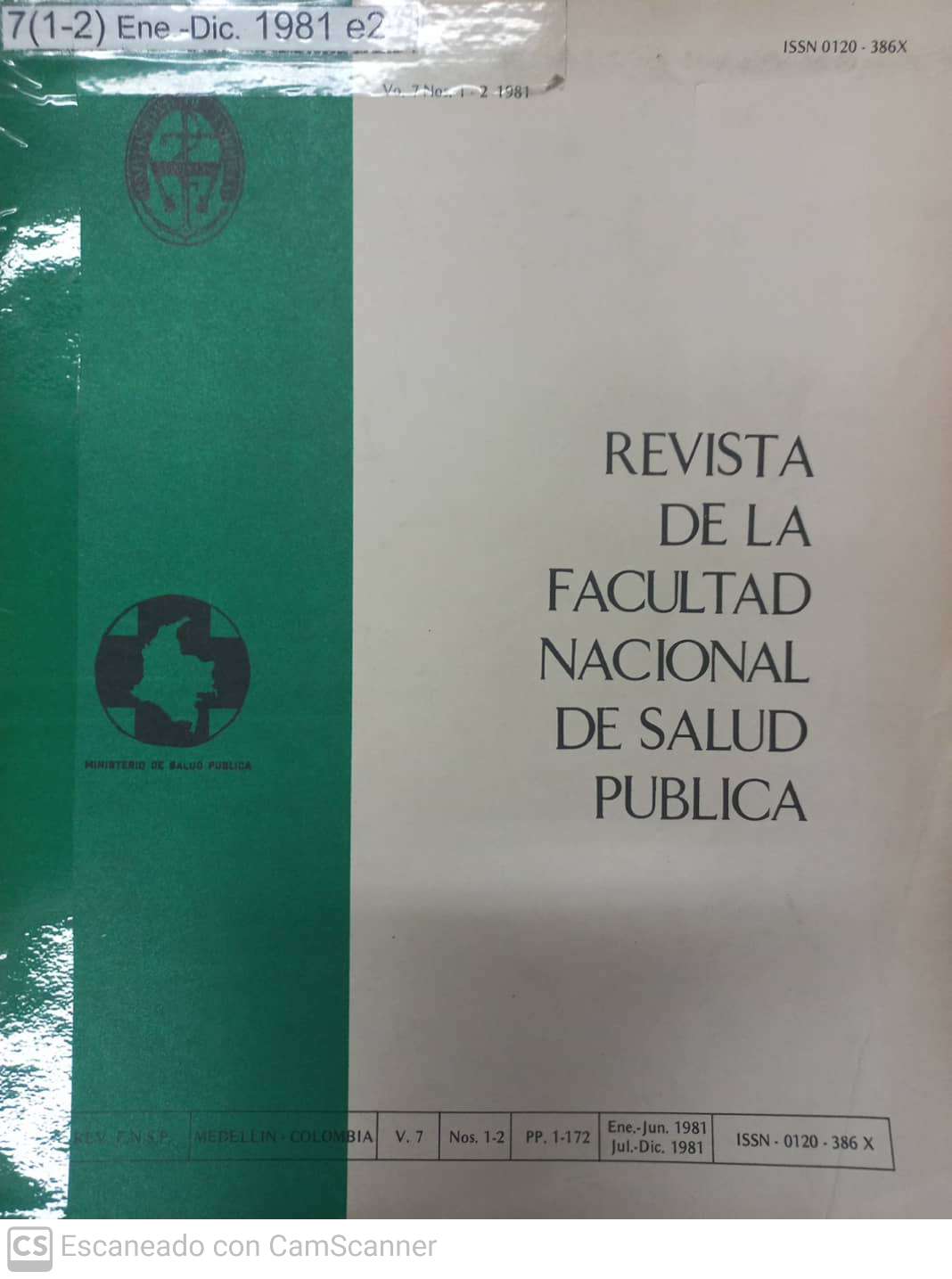INDICE DE TENSION TERMICA EFECTIVA USANDO UN COMPUTADOR DE BOLSILLO
Abstract
From: KAMON, E. and RYAN, C. Effective heat st rain index using pocket computer, American Industrial Hygiene Association Journal 42(8): 611-615, Aug. 1981
An effective heat stress index (EHSI) using a calculator with memory is suggested for the evaluation of conditions where a hot environment prevails.
Inputs to the programmed calculator include dry bulb, wet bulb and globe temperature and values for air movement and metabolism. The index is based on a program for calculating total heat balance and sweating efficiency. The resulting information on ambient conditions includes: total heat load; evaporative capacity of the environment; skin humidity and applicable heat stress. The EHSI output shows the following: No Voltage; Low Voltage; High Voltage or Exposure Time Limits.
Downloads
References
Kerslabe, D. McK.. The Stress of Hot Environments. Cambridge, Univ. Press, 1972.
Lee, D. H. K.. Seventy-five years of searching for a heat index. Environmental Research 22: 331 356, 1980.
Belding, H. S. and Hatch, T. F. Index for evaluating heat stress in terms of the resultin physiological strain. Heat. Pipe. Air Condit, 27: 129-136, 1955.
4. ACGHI. Threshold Limit Values for Chemical Subtances and Physical Agents in the Work Room Environment with intented Changes for 1972. American Conference of Governmental Industrial Hygienists. pp. 69 - 79, 1972.
Department of Labor. Recommendation for a Standard for Work in Hot Environments. Draft No. 5 Standard Advisory Committee on Heat Stress. Washington, DC. Full test giben by Bu, of Natl. Affairs, Occupational Sa- fety and Health Reporter 3: 1055, 1974.
Botsford, J. H. A wet globe thermometer for environ- mental heat measurements. Am. Ind. Hyg. Assoc. J. 32: 1-10, 1971.
Pulket, C., A. Henschel, W. R. Burg And B.E. Saltz- man: A comparison of heat stress indices in a hot-humid environment. Am. Ind. Hyg. Assoc. J. 41: 442 449, 1980.
Botsford, J. H. A simple method for limiting personal heat exposure. Am. Ind. Hyg. Con. Abstract, 1980.
Hatch, T. F. Assessment of heat stress in Temperature. Its Measurement and Control in Science and Industry, edited by J. D. Hardy. Reinhold, NY, v. 3, pp. 306- 318, 1963
Romero Blanco, H. A. Effect of Air Speed and Radia- tion on the Difference between Natural and Psychro- metric Wet Bulb Temperature. Masters Thesis, Universi- ty of Pittsburgh, 1971.
AIHA. Ergonomics guide to assessment of metabolic and cardiac cost of physical work. Am Ind. Hyg. Assoc. J. 32: 560 564, 1971.
ALHA. Heating and cooling for man in industry. 2a, ed, Chicago, Am. Ind. Hyg. Assoc., 1975.
Kamon, E. Ergonomics guide to matching physically demanding job to the worker. Am. Ind. Hyg. Assoc. J. (in review).
ASHRAE: Handbook of Fundamentals. New York. Am Soc. Heat. Refrg. Air Cond. Eng., 1972.
Haines. G. F., Jr. and Hatch, T. Industrial heat expo- sure evaluation and control. Heating and Ventilating Nov. 1952.
Nishi, Y. and Gagge, A. P. Moisture permeation of clothing a factor governing thermal equilibrium and comfort. ASHARAE Transaction No. 213576: 137 145, 1970.
Gagge, A. P., Stolwijk, A. J. and Saltin, B.. Comfort and thermal sensations and associated physiological respon- ses during exercise at various ambient temperatures. En- viron. Res. 2: 209-229 (1969).
Kamon, E., Avellini B., and Krajewski, J.. Physiological and biophysical limits to work in the heat for clothed men and women. J. Appl. Physiol.: Respirat. Environ. Exer. Physiol. 44: 918-925, 1978.
Candas, V., Libert, J. P. and Vogt, J. J. Human skin wettedness and evaporative efficiency of sweting. J. appl. Physiol.: Respirat. Environ. Exer. Physiol. 46: 522-528, 1979.
Health Factors involved in working under conditions of heat stress, Geneve, World Health Organization 1969 (Technical Report Series, 412).
Downloads
Published
How to Cite
Issue
Section
License
Copyright (c) 2024 Jorge Puerta

This work is licensed under a Creative Commons Attribution-NonCommercial-ShareAlike 4.0 International License.
The contents of the articles are the responsibility of the authors
The editorial committee has editorial independence from the National School of Public Health "Héctor Abad Gómez" of the University of Antioquia.
The editorial committee is not responsible for aspects related to copying, plagiarism or fraud that may appear in the articles published in it.
When you are going to reproduce and disclose photographs or personal data in printed or digital format, informed consent is required. Therefore, this requirement is required of the author at the time of receipt of the manuscript.
Authors are responsible for obtaining the necessary permissions to reproduce any material protected by reproduction rights.
The authors preserve the moral rights and assign the economic rights that will correspond to the University of Antioquia, to publish it, distribute electronic copies, include them in indexing services, directories or national and international databases in Open Access, under the Creative Commons Attribution license -Not Commercial-Share Equal 4.0 International Commercial (CC BY-NC-SA) which allows others to distribute, remix, retouch, and create from the work in a non-commercial way, as long as the respective credit and license are granted. new creations under the same conditions.
The authors will sign the declaration of transfer of economic rights to the University of Antioquia, after the acceptance of the manuscript.
The editorial committee reserves the right to reject the articles whose authors do not offer satisfactory explanations about the contribution of each author, to meet the criteria of authorship in the submission letter. All authors must meet the four criteria of authorship according to ICMJE: "a) .- That there is a substantial contribution to the conception or design of the article or to the acquisition, analysis or interpretation of the data. b) That they have participated in the design of the research work or in the critical review of its intellectual content. c) .- That has been intervened in the approval of the final version that will be published.d). That they have the capacity to respond to all aspects of the article in order to ensure that issues related to the accuracy or integrity of any part of the work are adequately investigated and resolved. "








 --
--  --
--
